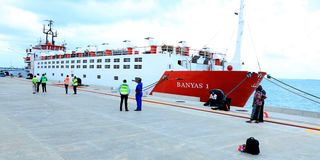The Lamu port project, Lappset corridor key to expanding Kenya’s GDP

Mv Banyas 1 Lome Vessel which docked at the Port of Lamu Berth Number 1 in this photo taken on October 15, 2022.
A report in the Business Daily last week noted that the Lamu port has been off to a slow start. The report, however, failed to recognise Lamu’s long and rich history.
At 700 years, it is one of the oldest and continuously inhabited towns along the East African coast. It has always been a port and has drawn the attention of maritime powers – Oman, Turkey, Portugal, Britain, Germany, China – throughout the ages.
The report was of course talking about the modern reincarnation of Lamu port. This deep-sea modern port will have 32 berths.
Three are complete and in operation and the 13 ships the BD reported on have called on the port over the past year. The deep harbour means very large ships can dock, allowing transshipment.
The port sits atop the Lappset corridor, which aims at opening a new, modern road, rail and pipeline link to northern Kenya, South Sudan and Ethiopia. Pundits, myself included, enthuse that it will open up half of the country and more than double Kenya’s GDP.
Like the old Mombasa-Kisumu-Malaba corridor, whose railway was labelled the lunatic express, the new one attracted colourful commentary at inception as well. To date, there are many skeptics.
Kibaki’s Mr Fix-it
I first encountered the idea from Alex Kibaki Muriithi, David Waithaka and Ambassador Muthaura. Alex was regarded as President Kibaki’s Mr fix-it, David was with the South Sudan Liaison office and of course, Ambassador Muthaura was the head of Public Service and Secretary to the Cabinet. As a young finance professional then, it was my role to arrange meetings with financial institutions in South Africa for Alex to pitch the idea.
The proposed multi-phase project was referred to as the ROOLA (railways, oil, [fiber] optics and Lamu airport). The government seniors felt it could be implemented as a BOOT – build-own-operate-transfer.
How does BOOT work? Identify a concessionaire. Then the concessionaire raises money to build, own and operate the facility. After the agreed concession period, they transfer the asset to the government. Thus the government does not have to borrow or otherwise raise the money itself. Which should be music to our ears, given the daily chorus on over-borrowing!
In the often toxic political discourse, however, all hell broke loose. In August 2006, a newspaper report termed the project ‘grandiose’. The report noted that a Kuwait-based firm was about to clinch a lucrative (sic!) contract with the Kenya government for the exclusive rights to develop multimillion-dollar projects in Lamu!
At that time, of course, no detailed feasibility studies, nor design work, had been completed or any commitments made. Al-Bader Group, the firm in question, had expected to approach investors in China, India and Arab countries while Kenya would sign off the BOOT, but the negative sentiment put off would-be financiers.
Undeterred, the government proceeded with the feasibility and design work. The corridor took on a more regional character, incorporating South Sudan and Ethiopia, and construction began. Ten years later, the port is operational. Ambitious, not grandiose!
@Ndiritu Muriithi is an economist





